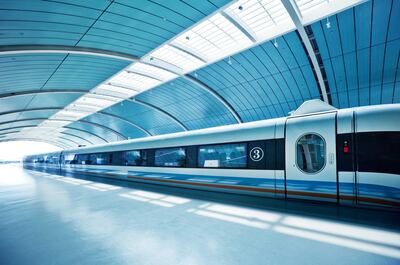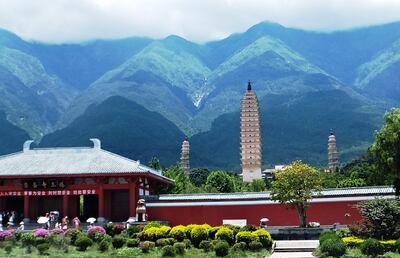The large LCD display above me reads: 245kph. We are moving remarkably fast. And yet, I was unaware that the train I'm travelling in had reached such an advanced speed until I looked up from my phone and read this display. That's because the train had not only accelerated very swiftly, but had done so ultra-smoothly and near-silently.
As I lean back in my comfortable second-class seat, which is as spacious as a business class plane seat, I look out of the window. The countryside of China's Yunnan Province is passing by, almost in a blur. I see a farmer bent over tending to his field with a handheld instrument. As he goes about an ancient occupation in an antiquated fashion, I am whizzing past in a state of-the-art bullet train.
Catching up to the future
In the past 20 years, few other nations have managed to modernise themselves as quickly as China. It is racing into the future at a pace even its army of bullet trains cannot match. These hyper-modern machines, which can reach 350 kilometres per hour, are perhaps the single greatest symbol of China's technological advancement. The state-owned China Railway Corporation, which is responsible for the country's gigantic rail network, runs more than 130,000km of rail line across China. About 29,000km of these lines are high-speed rail. That latter number is patently huge. But to understand just how phenomenal it is, consider that it's about ten times greater than the second-longest high-speed rail network in the world, operated by Japan (about 2,900km).
Japan has long been synonymous with bullet trains. When its Shinkansen network opened in 1964, it was the world's first high-speed rail service, with a top speed of 210kph. At that time, China's rail network was extremely outdated by comparison. It was not until 1961 that China got its first electrified railway line, something Japan had been using since the late 1800s. But skip forward to 2019 and China has left Japan in the dust. Of all the kilometres of high speed commercial rail operating in the world, about two-thirds are in China. And there are no signs of it slowing down either, with Beijing last week announcing plans to spend a further $119 billion (Dh437bn) on its rail network this year.

From a tourism perspective, the money China has poured into its high-speed railway has been well spent. Across a dozen visits to China in the past decade I've travelled thousands of kilometres on this high-speed network. The ease with which it enabled me to move between China's dozens of large cities made travelling in the country far simpler and more enjoyable. Once I used to take a two-hour flight to cover the 1,300km distance between Shanghai and Beijing. Now I catch a bullet train, which takes four-and-a-half hours. Compared to air travel, the seats are more spacious, the services run on time, and there are fewer security procedures and waiting periods.
Crucially, these high-speed trains have also opened up great opportunities for day trips from the bigger cities. It allows tourists to easily access places within a radius of 400km of many Chinese metropolises. This has opened up smaller towns and locations of natural beauty which were previously isolated and required lengthy travel times and an overnight stay.
A new route to test out
On one recent rail trip, in July last year, I was travelling through a comparatively wild and isolated province in the far south-west of the country, near the edge of the Tibetan Plateau. I was doing a day trip with my mother that would take us from Kunming, the capital of Yunnan, to the city of Dali. The previous time I did this round-trip rail journey was in 2013, and it took more than seven hours. The train then was uncomfortable, dated and slow. An ancient lakeside city flanked by mountains, Dali was so beautiful and intriguing that I wanted to show it to my mother. Initially I ruled out such a trip as I thought the long and tiring return journey would be too difficult for her to complete in one day. Then I saw that a high-speed rail service had opened on this route just weeks earlier.
As my mother and I sipped fresh coffee while speeding towards Dali, we chatted about how much our native Australia would benefit from a rail network like this. Outside the window, the natural splendour of Yunnan Province unfurled. Densely forested hills, crystal-clear lakes, lush farmland. This is the China few foreigners seem to know about. Whenever I talk to people about my frequent visits to the country, they ask mostly about negative aspects. Pollution. Traffic. Crowds. Concrete jungles.
But as an enormous nation with a land area more than twice the size of the entire European Union, it should be no surprise that China is blessed by Mother Nature. There are tropical beaches, vast plains, mountains, deserts and lush forested valleys. Dotted amid these attractive areas are historic towns and villages where ancient customs and lifestyles live on, giving visitors an insight into a traditional China that is quickly being left behind. When I first visited the country in 2006, visiting these natural wonders and isolated villages was hard work. Now, they are easy to explore.
Of all the provinces I've visited – 15 and counting – Yunnan may just be the most beguiling. It offers a window into contemporary China via Kunming, a modern city of four million people spiked by skyscrapers, huge shopping malls and gleaming new museums. But it is once your bullet train leaves this urban tangle behind that you view the real Yunnan. Open fields fringe small old villages over which hills loom. Then large buildings come back into view as you arrive in Dali.
Dating back more than 1,500 years, Dali is a throwback to old China, thanks to its cobblestone streets, time-worn shophouses, ancient temples and historic neighbourhoods, which have barely changed in centuries. My mother and I soaked up this history and had just enough time to visit the pristine Erhai Lake, on the shores of which Dali is built. It is about about 40km in length and nearly 10km across at its widest point. Yet even it is overshadowed by the Cang mountain range. At up to 4,100 metres high, these peaks tower over the city.

You would never know, but while you're zooming towards Dali from Kunming you are steadily gaining in altitude. That's because you're making the climb towards the "Roof of the World" – the Tibetan Plateau. The high-speed rail line continues well beyond Dali, stretching a further 140km into the mountains to the ancient city of Lijiang, at a lofty altitude of 2,400m. And it won't stop there. While no plans have been announced, I have little doubt that one day these bullet trains will ascend up on to and then across the Tibetan plateau. China's fierce ambition convinces me so.











